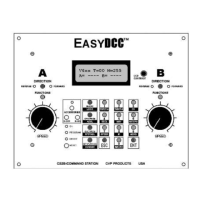137
A speed step is actually a value representing a percentage of full speed at which the motor runs.
DCC has three specific values for the numbers of individual steps used between off and full
motor speed. The available speed step settings are 14, 28 and 128.
This graph shows the relationship between decoder speed steps and the motor speed. For this
illustration, there are two speed curves shown, one for more coarse 14 speed steps and the other
for the better 28 speed step curve. The 128 mode is not shown but would be a curve having 128
discreet speed steps.
The motor starting voltage (MSV) sets the speed at which the motor “jumps” to when the throttle
is set to output the first step. The MSV may be any value up to full speed. CV2 holds the value to
be used for the MSV.
The acceleration rate value (ACCL) and the deceleration rate value (DECL) program the “rate”
at which the decoder changes between speed steps.
Consult the decoder documentation to determine how MSV, DECL and ACCL values are used
when the decoder is set for 128 speed steps. Some brands of decoders ignore these values, other
brands of decoders ignore all but the MSV.
For applications where locomotives operate in consists, either 14 or 28 steps are recommended.
This allows the use of various ACCL, DECL and the MSVs to insure smooth locomotive
operation.
What Are Decoder Speed Steps

